Text



my desk is messy and laptop dusty but it's whatever lol
159 notes
·
View notes
Text


i do like a good little note taking session in a cute café ☕️
2K notes
·
View notes
Text


Free Phone/Tablet Icons & Backgrounds
It's Day 10 of the 12 Days of Giving!
Sometimes refreshing your digital space is the spur of motivation you need. To give your homescreens a cute, playful look - here are 100+ icons for all your favourite apps. Replace them and enjoy a funky look! Features include:
5 alternating colours
3 included backgrounds
instructions guide
103 icons
Download Free Here
Check back in each day for a new free item! Hopefully they're all useful and a fun way to end the year 🥰🎁
149 notes
·
View notes
Text


Free Intentional Spending Tracker for Notion
It's Day 8 of the 12 Days of Giving!
Track your wishlist and fill in details to help make more informed decisions regarding your purchases. Comes with an comprehensive way to categorise your wants & seeing the impact on your budgets. Whilst this has budgeting features, it's more about how you're spending and making sure those purchases are considered.
Features include:
spending goals for 2024
active wishlist & watching space
detailed digital wishlist and budget impact
wishlist categorises & year budgeting
pre-populated dates with calendar view for revisiting items after "cool off period"
gift gifting ideas (by idea, rather than recipient for more intentional gifting!)
recipient database
Download Free Here
Check back in each day for a new free item! Hopefully they're all useful and a fun way to end the year 🥰🎁
453 notes
·
View notes
Text



tbt to January this year, when I still learned Swedish! Maybe I have the time to take the B2 course next semester
1K notes
·
View notes
Text
Free digital bullet journal and planner!
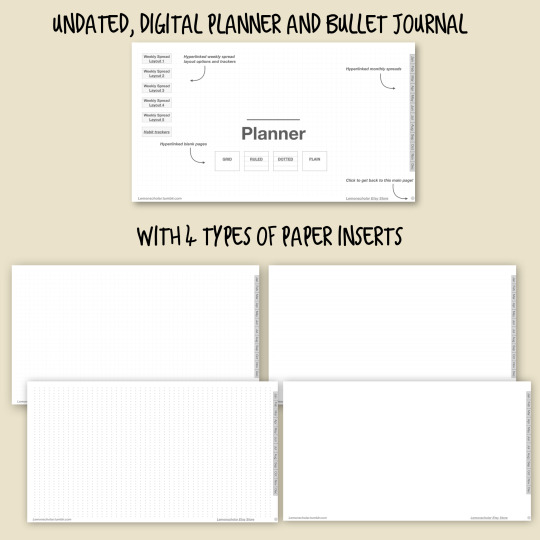


I’m a firm believer in going digital, and I wanted to share that with others in a little new years treat! I’ve created a very simple undated grid digital planner with FIVE different bullet journal weekly spreads that I use A LOT as a student. I find myself going back and forth between these styles quite often, depending on the week and my needs for that week.
This download includes:
undated, 12-month yearly calendar with hyperlinks to each calendar month
5 different weekly spreads
grid, dot grid, ruled, and plain paper spreads
habit and mood tracker, plus a year in pixels section!
You can download my undated digital planner here: Undated Digital Bullet Journal and Planner
This digital planner can be used in any pdf viewer and note annotater, like Goodnotes, Notability, or OneNote! Be sure to tag me if you end up using these, and please no redistributions or resales.
Please consider supporting me by visiting my tumblr and giving me a follow and/or check out my Etsy shop!
184 notes
·
View notes
Photo
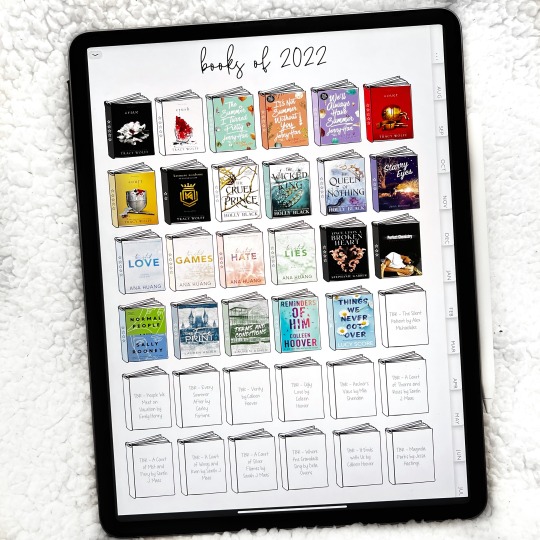
book tracker and some of my tbr list ♡
want a free PDF of this tracker? click here!
what are some of your favorite books you’ve read this year?
76 notes
·
View notes
Text
Batchim rules
There are 7 key batchim rules that depend on the consonants used. Some characters like ㄱ, ㅋ, and ㄲ share the same rule as you can guess because they are very similar consonants.
ㅇ = ㅇ
ㄱ, ㅋ, ㄲ, ㄳ, ㄺ = ㄱ
ㄷ, ㅌ, ㅅ, ㅆ, ㅈ, ㅊ, ㅎ = ㄷ
ㅁ, ㄻ = ㅁ
ㅂ, ㅍ, ㅄ, ㄿ = ㅂ
ㄹ, ㄼ, ㄾ, ㅀ = ㄹ
ㄴ, ㄵ, ㄶ = ㄴ

I’ll lay it out like this:
WORD –> PRONOUNCIATION : ROMANIZED
1. Rules for ㅇ
Starting off with ㅇ because it’s important to batchim rules overall. Once you learn how to read hangul you learn ㅇ is either an empty space when used first (like 아니) or an ‘ng’ sound at the very end (like 사랑).
The ‘ng’ sound is the ㅇ characters batchim, it never changes. BUT there’s more- if ㅇ begins the next syllable in a word the batchim will change:
있어 –> 이써 : isseo
있다 –> 읻다 : et-da
For the first one the bottom consonant ㅆ takes over the space of ㅇ for pronunciation making it sound more like 이써. 있다 above follows the normal batchim rules and the ㅆ takes on a ㄷ sound.
2. ㄱ, ㅋ, ㄲ, ㄳ, ㄺ = ㄱ
This rule affects consonants including ㄱ or his relatives and simply makes anything a ㄱ sound no matter how hard the character would be on its own. Even ㄳ which is combo k and s becomes just k sound.
한국어 –> 한구거 : hangugeo
책은 –> 채근 : chekgun
3. ㄷ, ㅌ, ㅅ, ㅆ, ㅈ, ㅊ, ㅎ = ㄷ
This affects a bunch of consonants so it’s important to remember.
꽃 –> 꼳 : ggot
좋다 –> 조타 : jota
There’s a special rule about ㄷ and ㅌ ending before a ㅇ though. You’ve probably heard it with 같이; instead of becoming 가티 the ㅌ changes to ㅊ making it 가치. ㄷ changes to ㅈ as well.
같이 –> 가치: kachi
4. ㅁ, ㄻ = ㅁ
몸이 –> 모미 : momi
5. ㅂ, ㅍ, ㅄ, ㄿ = ㅂ
없다 –> 업따 : ob-da
없어요 –> 업서요 : ob-seoyo
Now ㅂ has some special rules for itself, you probably knows 감사합니다 but it’s not pronounced kamsahaBnida it’s more like kamsamnida
ㅂ starting a word – use a softer b sound: 바나나
ㅂ in the middle – it creates a b sound: 일번
ㅂ at the bottom – can have m sound depending on what follows like in 감사합니다
A trick to think of is try saying 감사합니다 20x fast. Maybe originally the word was pronounced fully but people get lazy, slur their words, etc and pronunciation goes towards what’s easiest.
6. ㄹ, ㄼ, ㄾ, ㅀ = ㄹ
별이 –> 벼리 : byeo-re
핥은 –> 할튼 : halteun
7. ㄴ, ㄵ, ㄶ = ㄴ
앉다 –> 안다: anta
돈이 –> 도니 : doni
158 notes
·
View notes
Text
Vocabulary: house (rooms)
2023년 9월 19일
안녕하세요!
Today, we will learn how to say each room of the house!
House: 집
Bathroom: 화장실
Dining Room: 식당
Bedroom: 침실
Kitchen: 부엌
Living room: 거실
Downstairs: 아래층
Upstairs: 윗층
Garage: 차고
Garden: 정원
206 notes
·
View notes
Text
Vocabulary: house (rooms)
2023년 9월 19일
안녕하세요!
Today, we will learn how to say each room of the house!
House: 집
Bathroom: 화장실
Dining Room: 식당
Bedroom: 침실
Kitchen: 부엌
Living room: 거실
Downstairs: 아래층
Upstairs: 윗층
Garage: 차고
Garden: 정원
206 notes
·
View notes
Note
Hiii I was wondering if you can do a lot of sentences of how 이/가 and 는/은 are different. Maybe some include the 을/를 too. And also some that have both 는/은 and 이/가 ☺️☺️
anon asked: I see a lot of posts on Tumblr about 이/가 but they just leave me more confused. Can you help? thanks
Sentences to Showcase the Usage of 이/가 and 은/는: [+what are they?]
Please go here for more context on how/when to use them. This post will be kinda long, so I’ll put a TLDR at the top.
TLDR; if the main noun is an agent then use, 은/는 or if the main noun is an experiencer, then use 이/가
Now, what the hell is an agent or an experiencer. A good way to figure this out is to ask yourself, “is the entity doing the action or undergoing the event?” 은/는 are general particles (commonly used for the agent as they are the ones doing or causing the action), whereas 이/가 are particles used to emphasize (commonly used for the experiencer as they are in contact with the event; I will explain more later in the blog). Both are nominative—which is what makes the argument of “subject” and “topic” extremely confusing and meaningless because they don’t accurately identify the noun’s role in the sentence.
I am fortunate enough to have studied thematic roles and syntax in depth during my time in linguistics, however, I understand that a lot of my followers haven’t! So, I will give you a visual:
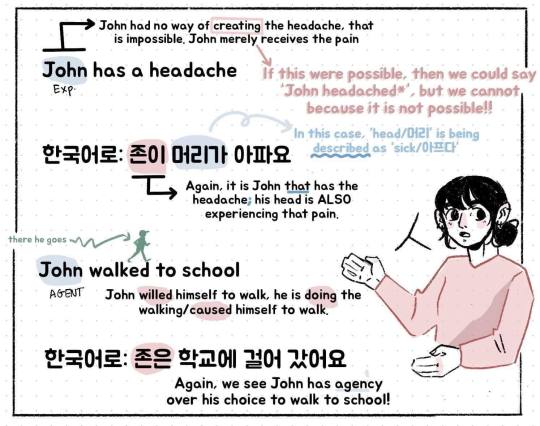
So again, ask yourself, “who/what is doing/causing the action?” or “who/what is undergoing the event?” Sometimes, it is also easy to look at the verb or adjective and make a judgement there considering it's common** for 이/가 to go with adjectives and common for 은/는 to go with verbs. Another way to think about it: if you need to place emphasis on the agent, then you can use 이/가.
** just because it's common, it does not mean it's a rule (however, it is a good tip)
Below is an example of why the above statement is not a rule.
이다 [to be] is special because it is a copula. A copula is a verb that joins/links the main noun and it's complement. We have many copulas in English (BE, feel, smell, look, become--to name a few). Korean has three: 이다, 아니다, and 되다.

Let’s try to place it in a sentence where both 은/는 and 이/가 occur in contrast:
매일 신발들은 신어야 하는데 오늘은 이 신발이 안 신으면 안 돼요
In the sentence above ^^, the dependent clause [매일 신발들은 신어야 하는데] gives background information for the main clause [오늘은 이 신발이 안 신으면 안 돼요]. “Generally,” the speaker says, “everyday I have to wear shoes, but I must wear these shoes [specifically] today.”
The sentence shows that there is something emphasized about the shoes; “these shoes must undergo being worn by me”. Whatever the reason may be, the speaker intentionally highlighted the shoes in the second clause as the ones that they must wear that day.
Summary so far:
1) If the main noun is doing the action, use 은/는
2) If the main noun is undergoing the action, use 이/가
3) If you want to emphasize the main noun, use 이/가
Hopefully, you’re still following me. Let’s look at other examples:
오늘은 날씨가 좋아요 - today, the weather is good
그 이어폰은 제 게 아니에요 [게 = 것+이] - Those earphones aren’t mine
새로운 선생님이 여자예요 - the new teacher is a woman
선생님은 한국 분이 아니에요 - the teacher is not Korean
제 이름은 지연이 아니고 희주예요 - My name is Heeju, not Jiyeon
비빔밥 말고 다른 한식이 있어요? - Other than bibimbap, do you have other Korean food?
그 남자는 캐나다에 갈 때 미혼이 아닐 거 같아요 - I don’t think that man will be single if/when he travels to Canada
Here’s the worst part; sometimes, there’s no fkn difference between the meanings. Which also makes it confusing. So, try to stick to the rules in the post linked and the patterns from this post.
1. Use 이/가 after an object when you’re describing an agent’s feelings or state of mind
EX. 존은 책을 읽는 게 좋아요; 존은 책이 좋아요 = John likes (reading) books
2. Use 이/가 after the noun that precedes (goes before) a copula
EX. 존은 한국에 온 지 3년이 되었어요 = John has been in Korea for 3 years
3. Adjectives and Intransitive verbs (no object), can take on 이/가 if you want to emphasize the main noun
EX. 내일은 날씨가 바람이 불 거 같아요 = It seems like it’s going to be windy tomorrow
4. Transitive verbs (takes an object), usually use 이/가 for the first noun and 을/를 for the object
EX. 존이 이를 닦는 중이에요 = John is [in the middle] of brushing his teeth
Okay! I really hope this helped! If there’s still any confusion, please don’t hesitate to send me a message to ask for clarification or more examples! 이/가 and 은/는 are honestly some of the hardest for English speakers learning Korean to grasp because we don’t really have particles like this that distinguish nouns in English. Though, with this, I hope you can get better at it!
Happy Learning :)
~ SK101
334 notes
·
View notes
Text

Easiest Korean Particles
N처럼, N같이
N마다
N쯤
N이나
N처럼, N같이 = Like [Noun]
Usage: Kind of like a “simile” in English and it corresponds to “like” or “as”. When you want to express that an action appears the same or similar to the noun you attach 처럼 or 같이 to.
Note: 처럼/같이 are often used metaphorically to compare characteristics by comparing them to other things.
Examples:
그 남자는 말처럼 빨리 달려요. He runs as fast as a horse.
지민 씨는 천사같이 노래해요. Jimin sings like an angel
그녀의 머리는 아이돌처럼 예뻐 보여요.
Her hair looks as pretty as an idol.
N마다 = Every [Noun]
Usage: This is attached to nouns that express a time - time nouns. To indicate the repetition of the same/similar situation or behavior over a set period of time. It can be translated as “every”, “each”, “once every“. It’s added directly next to the time noun being described.
Examples:
주말마다 여행을 가요. I go on a trip every weekend.
금요일마다 친구를 만나고 외식을 해요. Every Friday I meet my friends and (we) go out to eat.
우리 집에는 방마다 티비가 있어요. There’s a tv in every room in (our)my house.
Note: It can also be added to non time nouns - regular nouns.
Ex: 학생마다 달라요. Each student is different.
No need to add it to words that have 매 in them as it indicates “every ___”
매일 (everyday) → 매일마다 (X)
날 (day) → 날마다 (everyday)
N쯤 = About [Noun]
Usage: It’s added to nouns that represent numbers, times, and quantities. It indicates an approximation - “about” or “around”.
Examples:
넌 열다섯 살 쯤 되어 보여요. You look about 15 years old.
한시쯤 어때요? 수업이 열두시 오십분에 끝나요.
How’s around 1 o’clock? My class ends at 12:50.
우리는 일년쯤에 중국에서 중국어를 공부할 거예요. We will study Chinese In China for around a year.
Extra Notes:
When referring to approximate prices, ‘Noun쯤 하다’ is used more often than just ‘Noun쯤이다’.
Example:
사과는 세개에 이천원쯤 해요.
Apples cost about 2000 won for 3.
N이나 = Noun Or Noun
Usage: This actually has 3 usages, but we will focus on the main one which means “or”. It can only be attached to nouns. One of the two or more listed nouns will be chosen. (거나 means the exact same, but is attached to verbs instead)
Form:
Consonant - 이나
Vowel - 나
Examples:
목이 말라요. 물이나 차를 마시고 싶어요. I’m thirsty. I want to drink water or tea.
구두나 가방을 살 거예요. I’ll buy some shoes or a bag.
토요일에나 일요일에 운동해요. I exercise on Saturday or Sunday. (You can attach 나 to 에 or leave 에 out and just use 이나)
PRACTICE SECTION:
Something to keep in mind is that when you are using these particles you do not need to also attach the subject or object particles to them!
TRANSLATE EACH
1.) We go to Itaewon every Saturday night.
2.) I went to the hospital around 10:30 am.
3.) We talked for about 4 hours.
4.) My sister can dance like Jhope.
5.) Every 2 hours I drink water or tea.
102 notes
·
View notes
Photo
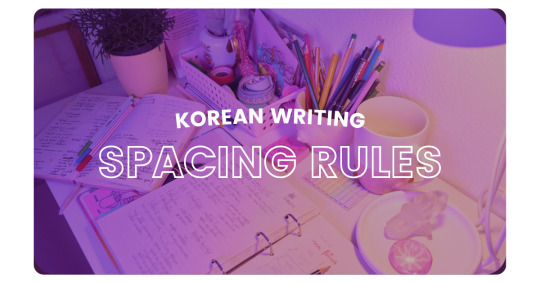
Writing in Korean can be quite complex when it comes to spacing (띄어쓰기), as it involves several factors like grammar, sentence structure, and even the type of words. In this article, I’ll share some of the most important rules I’ve learned with you.
1. Particles:
Korean uses particles to indicate grammatical relationships between words in a sentence. To ensure clarity, it is essential to separate these particles from the following words. Some commonly used particles in Korean include 은/는, 이/가, 을/를, 에, 에서, (으)로, 에게, 도, 와/과, and so on.
For example, in the sentence “저는 한국에서 떡볶이를 먹었습니다” (I ate Tteokbokki in Korea), there are three particles used: 는, 에서, and 를. To make it clear, it is essential to add spaces after each particle.
It is essential to note that particles are included as part of the preceding word. Therefore, particles are not standalone words and should be attached to the word they modify without spaces.
2. Independent Nouns:
In some sentences, there may be two or three nouns put together to form a noun phrase. In constructing such phrases, it is generally advisable to separate each independent noun with a space.
For example, “한국 음식” (Korean Food) and “경영 대학교” (Business University) both consist of multiple nouns that should be separated by spaces.
However, there are exceptions to this rule:
Compound Words: When words are combined to create a new meaning, they should be written without spaces. For example, “tear” in Korean is “눈물”, a compound word made up of 눈 (eyes) and 물 (water). This word should be written together as “눈물” without a space between them. The same applies to verbs such as “to visit,” which is “방문하다”, a compound word made up of “방문” (visit) and “하다” (to do).
Proper Nouns: If the noun phrase is a commonly used or official name, such “한국관광공사” (Korean Tourism Organization) or “국립중앙박물관” (National Museum of Korea), it is standard to write the entire phrase without spaces. Doing so makes it more easily recognizable as a specific entity or organization.
3. Person’s Name and Title
Korean personal names consist of a surname and a given name, both of which have independent meanings and can be used as separate words. Although it can be argued that they should be written separately, personal names are unique nouns, and Korean surnames are usually only one syllable, making them feel incomplete on their own. Therefore, it is customary to write personal names without spaces between the surname and given name.
For example, “Park Ji-min” is written as “박지민,” “Kim Min-seok” is “김민석,” and “Lee Min-ho” is “이민호,” all without spaces.
However, when titles or job names follow a personal name, they are separate units and should be written with a space between them.
For example: 박지민 씨 (Mr. Park Ji-min), 민수철 교수 (Professor Min Su-cheol), 김 의사님 (Doctor Kim) all have a space between the personal name and the title or job name.
4. Numbers and counters:
In Korean, spacing is used between every ten thousand when writing numbers. This means that if you have a number with five digits or more, you will use a space to separate the digits in groups of four.
For example:
이천이십삼 (2023)
구만 팔천칠백육십오 (98765)
일억 이천삼백사십오만 육천칠백팔십구 (123456789)
When it comes to combining numbers with counters, there are two cases to consider:
If you write the number in digits, there is no space between the number and the counter. For example, “1개” (one piece), “2번” (two times), and “3명” (three people) have no space between the number and the counter.
However, if you write the number in words, there should be a space between the written number and the counter. For example, “삼 학년” (third grade), “칠천 원” (seven thousand won), and “칠 개월” (seven months) have a space between the written number and the counter.
5. Word modifiers:
When a modifier (such as an adjective, verb, or adverb) modifies a word, it should be separated from the word by a space. This helps to clarify the relationship between the two words and make the sentence easier to read.
For example:
유나는 예쁜 여자예요 (Yuna is a pretty girl)
한국 와서 처음 먹은 음식 기억나요? (Do you remember the first food that you ate in Korea?)
저는 일을 잘 해요 (I do my job well)
All use spacing to separate the modifier from the word.
Additional Notes:
– It’s worth noting that there are certain grammatical structures in Korean that require specific spacing. For example, “(으)ㄴ 적이 있다” (have done in the past), “(으)ㄹ 수 있다” (can/be able to), “아/어 보다” (try doing) and so on. It’s important to pay attention to these spacing rules when learning Korean to ensure that your writing is accurate and clear.
– Finally, when using “이다” (to be) or “아니다” (to not be), it’s important to note that “이다” is written immediately after a noun, while “아니다” is written separately from the noun due to the particle. This is important to keep in mind when writing sentences that use these verbs.
For example:
학생입니다 (I’m a student)
학생이 아닙니다 (I’m not a student.)
The preceding explanation outlines my current understanding of the spacing rules when writing in Korean. However, I also want to point out that there might be some special cases or exceptions to these rules that I’m not aware of. So, if you have any experience with these special cases, I’d love to hear about it! Let’s share our knowledge and learn from each other.
🌸 🌼 🌻
Support me at: https://koreanlanguageloving.my.canva.site/
120 notes
·
View notes
Text
Different words meaning 'to use'.
이용하다 - to utilise something for the beneficial facility or function it offers (can also refer to taking advantage/exploiting in a negative way)
쓰레기통을 이용하세요 = please use the trash can
이용자 = a user/visitor of a facility or space
인터넷 이용자 = a user of the internet
도서관 이용자 = a library goer
사용하다 - to use, operate or employ a tool of some kind
컴퓨터를 사용해도 되나요? = May I use the computer?
사용설명서 = instruction manual (lit. usage + explanation + document)
사용자 = consumer/utiliser of something
스페인어 사용자 - user(speaker) of Spanish
유용하다 - to possess uses/functions, able to be utilised positively
병을 여는 데 아주 유용해요 = it's useful/great for opening bottles
이용한 표현을 배우야 해 = you must learn useful/useable phrases
쓰다 - to use or employ something or wear (in terms of some accessories) (also means 'to write' and 'to be bitter'.)
돈을 썼어 = I spent my money
안경을 쓰는 사람 = a person who wears glasses
이것은 어디에 쓰는 겁니까? = where/what is this used for?
연필을 쓰세요 - please use a pencil (whereas 연필로 쓰세요 would be please write in pencil
tldr: 쓰다 is more simple and common in speech but is essentially the same as 사용하다. 이용하다 has a different nuance of referring to making use of a facility offered by an object or space (e.g. using the bathroom, the internet, public transport) rather than 쓰다/사용하다 being the personal, often physical, manipulation of a thing (e.g. using toilet paper, using photoshop, using a pencil). 유용하다 is not about the actual use of something, more a remark on something's ability to be used/useful. The recurring ~용 character of these words comes from the Chinese/Hanja 用 which refers to use, function, utilisation, consumption.
125 notes
·
View notes
Text
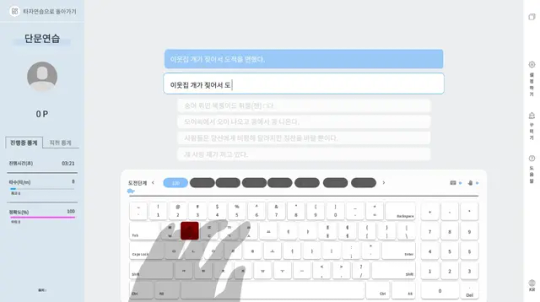
Hancom Typing Game
This site is in Korean but has the option for English in the top right corner. The site offers options for learning the proper typing form and going through the keys, typing out certain words, and typing out sentences as well. In the virtual keyboard it will tell you where the key is and show proper hand position as well, and just above will measure your speed.
I think this site works out well because there are different options to pick from; so if you’re a beginner just starting out you can focus on just learning the keys, then move on to words, and then full sentences. There’s opportunity for every skill level and benefits even people just wanting to improve their typing speed or form.
There’s also a leaderboard for people that like a bit of competition. There’s individual ones for each option, words, sentences, and stories so you can use that to fuel your drive to master typing!
119 notes
·
View notes
Text
Vocabulary: body.
2023년 7월 20일
안녕하세요!
Today i'll share some body's vocabulary.
Head = 머리
Face = 얼굴
Neck = 목
Shoulder = 어깨
Elbow = 팔꿈치
Arm = 팔
Hand = 손
Finger = 손기락
Thigh = 허벅지
Leg = 다리
Knee = 무릎
Feet = 발
Toes = 발가락
Next time i'll get into the face parts!
See you!
259 notes
·
View notes